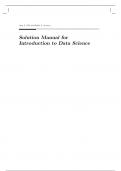Examen
Introduction to Data Science Data Analysis and Prediction Algorithms with R 1st Edition By Rafael Irizarry (Solution Manual)
- Grado
- Institución
Introduction to Data Science Data Analysis and Prediction Algorithms with R, 1e Rafael Irizarry (Solution Manual) Introduction to Data Science Data Analysis and Prediction Algorithms with R, 1e Rafael Irizarry (Solution Manual)
[Mostrar más]



